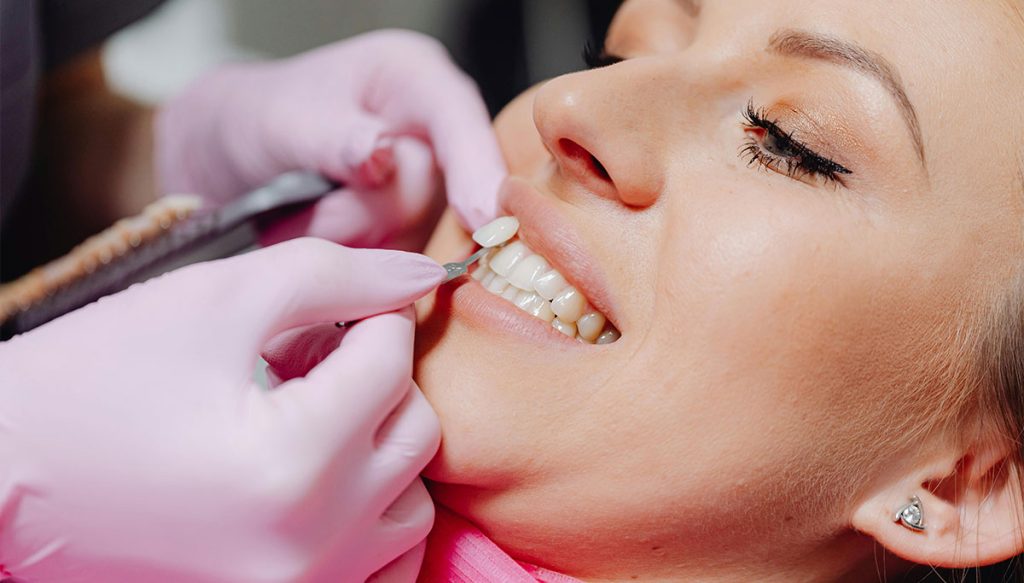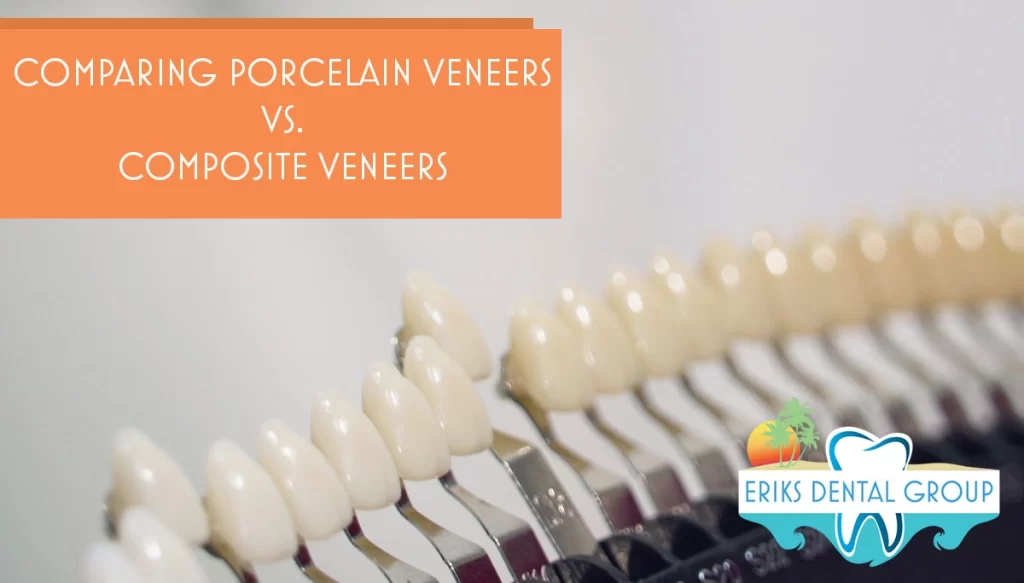- What are Porcelain Veneers?
- How Porcelain Veneers are Applied
- Benefits of Porcelain Veneers
- Disadvantages of Porcelain Veneers
- What are Composite Veneers?
- How are Composite Veneers Applied?
- Benefits of Composite Veneers
- Disadvantages of Composite Veneers
- Choosing Between Porcelain and Composite Veneers
- Schedule an Appointment with Eriks Dental Group to Learn More About Veneers
When you choose a cosmetic dental solution, you need to know how porcelain and composite veneers differ. Veneers consist of thin shells that fit over front tooth surfaces to correct discoloration, chips, or gaps. Porcelain and composite resin options each offer benefits and drawbacks that affect your smile.
Not sure where to start? Keep reading, as this detailed comparison helps you pick the veneer type that suits your needs, preferences, and budget.
What are Porcelain Veneers?
Porcelain veneers consist of custom shells crafted from high-grade ceramic material. Technicians form these shells in specialized labs to match your tooth color and shape. Porcelain delivers durability and a natural look that lasts. You also retain more of your tooth structure compared to some treatments because we remove only minimal enamel before placement.
How Porcelain Veneers are Applied

A porcelain veneer process requires two or more visits to our office. During the first appointment, we examine your teeth, discuss your goals, and confirm your suitability. We remove a thin layer of enamel—about 0.5 millimeters—to make room for the shells. We then take precise impressions and send them to our partner lab. We always protect your teeth with temporary shells until the final set arrives in one to two weeks. At your final visit, we bond each veneer with dental cement. We check fit, remove excess cement, and polish the margins for a seamless result.
Benefits of Porcelain Veneers

Porcelain veneers deliver strength that resists daily chewing forces and lasts up to 15 years or longer with proper home care. Their ceramic composition reflects light like natural enamel, so no one can tell your smile underwent a makeover. Porcelain also resists stains from coffee, tea, or tobacco, so your bright finish endures. You address multiple concerns, discoloration, misalignment, chips, or gaps, with one treatment plan. A smooth porcelain surface limits plaque buildup when you brush and floss.
Porcelain Veneers are Strong
High-grade dental ceramic offers structural reliability under normal bite forces. You enjoy a protective layer that safeguards your tooth against breakage while you bite and chew. When you maintain regular dental visits, your veneers can last well beyond a decade.
Porcelain Veneers Look Great
Porcelain delivers subtle light transmission that mimics enamel depth and translucency. Lab technicians layer ceramic shades to match natural tooth hues and gradients. The result blends with adjacent teeth and avoids that flat, opaque look.
Disadvantages of Porcelain Veneers
Porcelain often costs $900 to $2,500 per tooth, which can exceed many budgets. You trade permanent enamel removal for that premium finish. Once we remove enamel, your tooth requires restoration of some kind. You commit to one long-term solution. Porcelain shells require multiple visits over several weeks instead of a single office appointment. Although porcelain resists damage, a heavy bite or a direct blow can crack a shell beyond repair, forcing a full replacement. It’s worth noting that some patients feel tooth sensitivity after enamel removal. Most find that sensation subsides over weeks, but you should prepare for that possibility.
What are Composite Veneers?
Composite veneers consist of tooth-colored resin that we layer directly on your tooth. Dentists use the same material as tooth-colored fillings. We sculpt the resin to fit your smile, cure each layer with a dental light, and shape the final surface in one visit. Resin hardness and glass filler fragments deliver both strength and a true-tooth appearance.
How are Composite Veneers Applied?

We start by cleaning and drying your teeth. We match the resin shade to your natural teeth or desired brightness. If we need to roughen a tooth surface, we apply a mild etch agent. Then we place a bonding agent to lock the resin to your enamel. We shape thin layers of resin directly on your tooth, then harden each layer with a curing light. After the final layer, we sculpt contours, smooth edges, and polish the surface for a polished finish.
Benefits of Composite Veneers
Composite veneers cost $250 to $1,500 per tooth, which makes cosmetic work more accessible. We preserve your enamel when possible because we require minimal alteration of your natural tooth. Some cases allow full reversibility if you ever choose to switch materials. We craft your new smile in one visit, so no provisional shells appear while you wait.
Composite Veneers are Affordable
A lower price point lets you work on multiple teeth without breaking your budget. Even patients without dental coverage can pursue smile improvements thanks to resin affordability.
Composite Veneers Can Be Applied the Same Day
An office visit suffices to transform your smile with composite resin. We sculpt and refine each tooth in real time. You leave our practice with a renewed smile on that same date.
Disadvantages of Composite Veneers
Composite resin lasts four to seven years before you likely need a touch-up or replacement. The material proves more porous than porcelain, so stains from coffee, wine, or tobacco can dull the finish. You maintain excellent oral habits and schedule professional cleanings to minimize that risk. Additionally, composite resin can chip under strong stress. We can repair small chips, but major fractures require full replacement. Achieving a perfect color match proves more difficult than with porcelain, especially if you whiten natural teeth over time.
Choosing Between Porcelain and Composite Veneers

Your dental budget shapes your decision on which type of veneers to choose. Porcelain veneers cost more per tooth, yet last longer with fewer repairs. Composite veneers cost less per tooth yet require replacements sooner. Your lifestyle also matters. If you enjoy staining foods or drinks, porcelain avoids those issues. If you play contact sports or bite hard items, resin repairs come at a lower cost. Time availability may influence you. Resin veneers take one visit, while porcelain spans several appointments. We discuss your smile goals, oral health, and personal factors to guide your choice.
Schedule an Appointment with Eriks Dental Group to Learn More About Veneers
Your next step begins with a full consultation at Eriks Dental Group. Our cosmetic dentists will review your dental health, listen to your smile goals, and recommend either porcelain or composite based on several factors: durability, appearance, upkeep, and budget. Contact Eriks Dental Group today at (561) 733-4004 to schedule a consultation and learn more about the different types of veneers.

